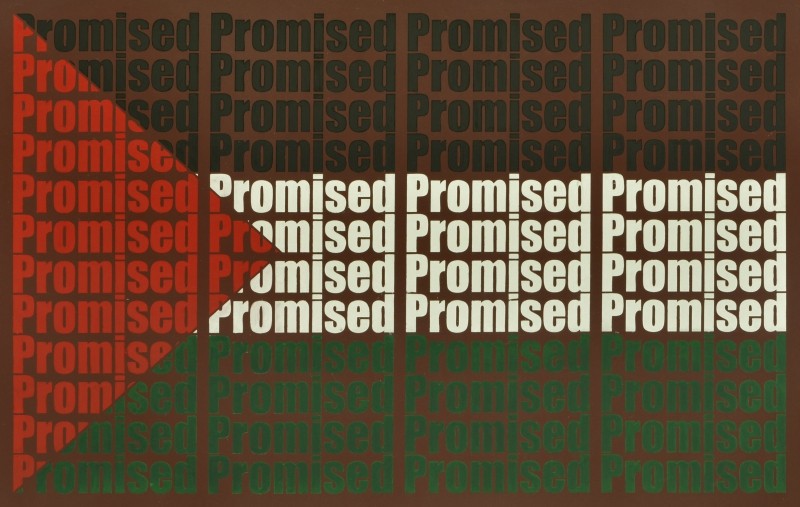
In his solo exhibition held at Sanat Initiative, Karachi, Muhammad Zeeshan addressed the relevance and sacredness of flags

"An identity cannot be a prison from which an individual, due to the banal reason of having been born, is held captive" -- Mario Vargas Llosa
Most of us insist on an identity bestowed by chance or accident of birth. One comes across attitudes of superiority, caused by these accidental identities, which reject, ridicule and repress others who do not belong to the same gender, sect, nationality, ethnicity etc. Occasionally, these differences end up in disputes, death and destruction.
Likewise, one hears generalisations about nations, gender, religion, and race: Africa is not a civilised continent, Muslims are extremists, men are monstrous, blonds are beautiful, Italians are frivolous, Pakhtuns are brave, French language is lyrical, Jews are the chosen race and so on. These are signs to form a ‘tribe’ and aim to discriminate the ‘other’.
These descriptions coined by others are, ironically, internalised by people holding a certain identity who happily and proudly accept and adapt with that classification -- as a mark of identity and nationalism.
There are other forms of national identity, like a country’s flag. These pieces of fabric -- of two, three or more colours, bearing some icons from nature -- signify the uniqueness of a people who live in an administrative unity. Perhaps one reason for these elements of nature on flags relates to the desire of connecting a territory and its sovereign to divine order; hence the sun, stars and moon.
In the solo exhibition of Muhammad Zeeshan, ‘Yeh Pyara Parcham’, the sacredness of these emblems, and their relevance, was addressed. Held from March 31-April 6, 2018 at Sanat Initiative, Karachi, a total of 10 flags of different states, all titled ‘The Great Pattern’, were displayed. The artist, who for this body of work confesses and desires to be working as an illustrator following some predetermined advice, had added text to these flags. These texts range from holy verses, anthems, labels of manufacturing to ancient/Biblical description of a land. In addition to that, one recognised birds, faces of famous figures, monuments and historic images in these visuals.
Zeeshan is not the only artist to have picked national flag to create an art work; others like Jasper Johns, Rasheed Araeen, Shahzia Sikander have also used this political product.
In this show, the US flag was constructed with a holy verse about the creation of universe -- on top of the unforgettable photograph of the Twin Towers hit by two planes. The work certified how the power of powerless sometimes changes the world order. A country that controls continents through its might was subject to another ‘command’ -- horrible, atrocious and awful, but carefully coordinated. A new world came into being, not out of creation but out of destruction.
On the Chinese flag, two identical but reverse portraits of Chairmen Mao were placed under the repeated phrase ‘Made in China’. A comment on the cheap Chinese items marketed around the globe, even their most revered personality was thus presented as a product. Manufacturing is the new cultural motto or national identity for China.
Sometimes, national identities may collide or end up being identical. Zeeshan created flags of two lands, Israel and Palestine, with a slightly altered description: ‘Promised Land’ for Israel and ‘Promised’ for Palestine. In a funny way, Zeeshan alluded to the promise that was made to two different peoples for the same land -- separately. One was fulfilled in 1948, the other is yet to be realised. Or to a political situation, in which both conflicting groups have the similar right to exist (what Amos Oz calls ‘between right and right’).
Intriguingly, most flags belonged to troubled locations, like Myanmar, Afghanistan and Syria. Vultures on Myanmar’s flag, ghost image of now vanished Bamiyan Buddha as the backdrop for Afghanistan’s and a diffused view of smoke erupting at an urban site in Syrian flag did not leave much for imagination or explanation. But the superimposed text accentuated the artist’s position on these crises zones.
Zeeshan has worked on the imagery of flags for the last eleven years. Tracing back works from 2007, such as ‘Let’s Make a Great Pattern’ and ‘Flag Ceremony’, Zeeshan has been deconstructing the edifice of national identity, and subsequently the notion of superiority linked with this symbol. ‘Flag Ceremony’ (from Braziers International Artists’ Workshop, 2007, and ‘Art Dubai’s Art Park Project’ 2008) consisted of layout of the US flag, composed with Pepsi Cola cans. At both venues, the viewers were invited and encouraged to pick a can from the setting. Somehow, an attempt was made to dismantle the symbol of the superpower -- through a product that represents it around the world.
Zeeshan created another piece ‘Refreshment’ in 2017. The subject was the same but he altered the ingredients and location, by fabricating the Pakistani flag with Pakola cans. This was a comment on the marketing strategy to use a commercial product to evoke national sentiments. Recalling that work, I remember seeing a supply van in Lahore that was promoting a soft drink with the inscription: ‘Mecca kola, mood mey masti laye (Mecca Cola brings exhilaration to mood)’. This is as imaginative as flags of different bands of colours which do not correspond to any country yet flutter outside many hotels.
In the same sense, the flags created by Muhammad Zeeshan in his exhibition strictly do not exist in their present formats with text, patterns and pictures. But who knows, in future, these may become the most respected, popular and circulated national emblems -- like the Pakistani flag with an image of Quaid-e-Azam or Mickey Mouse sold on every street close to Independence Day celebrations in August.